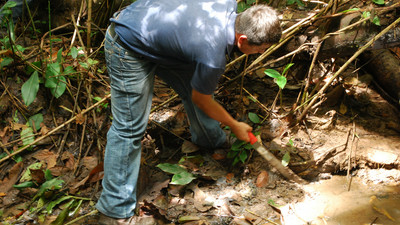The world's first high-level radioactive waste storage facility 'Onkalo' is scheduled to operate in Finland, the storage period is about 100,000 years

Finland built this tomb to store nuclear waste. Can it survive for 100,000 years? | Science | AAAS
https://www.science.org/content/article/finland-built-tomb-store-nuclear-waste-can-it-survive-100000-years
High-level radioactive waste has a great impact on living organisms and must be stored in isolation. This storage facility is named ' Onkalo ', which means 'cavity' or 'pit' in Finnish, and stores high-level radioactive waste in bedrock at a depth of 430 meters underground for 100,000 years.
The following movie introduces the inside of Onkalo.
Visit Onkalo - YouTube
Finland is promoting nuclear power generation, and more than 40% of Finland's electricity is covered by nuclear power generation. On the other hand, in nuclear power generation, high temperature and highly radioactive spent fuel rods are discharged, so this treatment becomes a big problem. In Finland, about 2,300 tons of radioactive waste was generated in 2019, but it seems that these are still stored in the interim storage facility.
Many experts agree that geological disposal such as Onkalo is the best solution for the disposal of high-level radioactive waste, but it is difficult to obtain the approval of local residents for final disposal sites for high-level radioactive waste. It is said that
In fact, in 2009, the Yucca Mountain radioactive waste disposal site, which was scheduled to be built in Nevada, USA, was canceled as ``not paying enough attention to the acceptance and involvement of the local community.''
On the other hand, residents of Eurajoki near Onkalo have an understanding of nuclear power generation, and Finland was able to approve it as a final disposal site in 2000. Finland's unique cultural and political conditions, such as a high degree of trust in nuclear power agencies and the Nuclear Energy Act, which encourages companies to develop solutions for radioactive waste disposal, are also said to have led to Onkalo's approval.

According to POSIVA , which develops and operates Onkalo, the bedrock of Onkalo is stable, and it is predicted that there will be no major earthquakes near Ankalo until the end of the next ice age.
On the other hand, groundwater was cited as a more serious threat than earthquakes, and workers digging Onkalo had to dig while avoiding groundwater. But even if groundwater somehow seeped into the radioactive waste reservoir, reaching the spent nuclear fuel would have to pass through the bentonite and copper that protect them, thus minimizing the spread of radioactive material. is believed to be possible or preventable.
Spent nuclear fuel rods that have been cooled for several decades in an interim storage pool arrive at Onkalo, where they are stripped of adhering moisture and sealed in copper containers after undergoing various processes. Copper does not corrode easily, and groundwater is rendered inactive by chemical reactions and microbial activity by the time it reaches storage facilities. In addition, the bentonite that surrounds the container is said to have the effect of preventing the invasion of microorganisms, and the life of the container is said to exceed 100,000 years.
In the unlikely event that radioactive material leaks from the container, it will take decades to affect the ground surface, and the radioactive level will decrease during that time, so the impact of the leaked radioactive material will be kept to a minimum. that's right.
On the other hand, not all Finnish concerns have been dispelled, and the Finnish Nature Conservation Society says it is concerned about long-term toxicity and bioaccumulation of radioactive materials. In addition, geologist Matty Cernisto argues that when the next ice age arrives, storage facilities may be damaged by freezing soil and rocks and applying pressure.
Onkalo is scheduled to start storing radioactive waste between 2024 and 2025, and when the storage facility is full in 2120, the Onkalo entrance tunnel will be sealed and all ground facilities will be demolished.
Onkalo geologist Antti Mustonen says, 'Onkalo is a rational way to deal with radioactive waste.' I feel it,' he said.
In addition, the movie on the theme of geological disposal of such high-level radioactive waste is `` Safety after 100,000 years ' ', and the trailer can be viewed from the following.
Movie 'Safety after 100,000 years' trailer-YouTube
Related Posts:







